SWEDISH SOUTH ASIAN STUDIES NETWORK
Reports from SASNET contact journey to India, November 2007
| Delhi | Thiruvanthapuram | |
Delhi:
Thursday 1 November 2007:
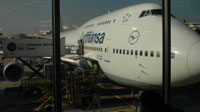 We left Sweden on Wednesday 31 October 2007, and arrived in New Delhi by the Lufthansa flight in the early hours of the next day. A taxi came to pick us up at the airport and took us to the Nordic Centre in India flat, in Nizamuddin East.
We left Sweden on Wednesday 31 October 2007, and arrived in New Delhi by the Lufthansa flight in the early hours of the next day. A taxi came to pick us up at the airport and took us to the Nordic Centre in India flat, in Nizamuddin East.
Back in Delhi after a couple of years we had great expectations, having read so much during the past years about the enormous progress being made in Delhi, and the improved environmental situation due to the shift over to Compressed Natural Gas (CNG) as fuel for the vehicles.
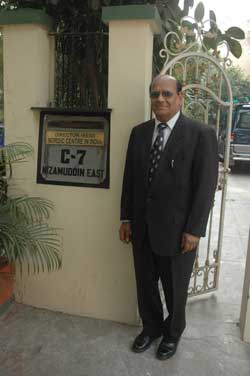 Nevertheless, driving through the city at night on bumpy roads mostly under repair (with occasional new-built flyovers crossing the way), the dirty smog surrounding us, it felt as if Delhi was much the same city as it used to be. The vision of a shining Delhi still a dream, even though no doubt the air actually has become less polluted.
Nevertheless, driving through the city at night on bumpy roads mostly under repair (with occasional new-built flyovers crossing the way), the dirty smog surrounding us, it felt as if Delhi was much the same city as it used to be. The vision of a shining Delhi still a dream, even though no doubt the air actually has become less polluted.
We were given accommodations at the Nordic Centre in India (NCI) flat in Nizamuddin East, off Mathura Road, one of the many gated communities in south-central Delhi. This is an oasis for academic visitors to Delhi if, like us, they happen to come from a member institution in the NCI university consortium. It is well-run locally by the energetic Delhi manager Mr. P.N. Malik (photo to the right).
Our first scheduled meeting was to be held in the afternoon, a visit to the Centre for Science and Environment (CSE).
Report from the Centre for Science and Environment (CSE)
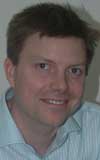 In the evening we were invited for dinner to Stefan Jonsson (photo to the left) and his wife Seema in their Chanakyapuri flat. Since August 2007, Stefan is working as Counsellor for Science and Technology at the Swedish Embassy (formally employed by the Swedish Institute for Growth Policy Studies, ITPS). He has a background in Economics from the Centre for Research on Innovation and Industrial Dynamics (CIND), Uppsala University and most recently at Stockholm School of Economics. In the early 1990s he was working for some years with the Swedish Sida supported Social Forestry project carried out in the Indian state of Orissa. His mission for ITPS consists to a large extent in establishing contacts within the fields of research and science.
In the evening we were invited for dinner to Stefan Jonsson (photo to the left) and his wife Seema in their Chanakyapuri flat. Since August 2007, Stefan is working as Counsellor for Science and Technology at the Swedish Embassy (formally employed by the Swedish Institute for Growth Policy Studies, ITPS). He has a background in Economics from the Centre for Research on Innovation and Industrial Dynamics (CIND), Uppsala University and most recently at Stockholm School of Economics. In the early 1990s he was working for some years with the Swedish Sida supported Social Forestry project carried out in the Indian state of Orissa. His mission for ITPS consists to a large extent in establishing contacts within the fields of research and science.
Seema Jonsson is a researcher from the Dept. of Urban and Rural Development, Swedish University of Agricultural Sciences (SLU) in Uppsala. In 2005, she defended her doctoral thesis on ”Unsettling the Order: Gendered subjects and Grassroots activism in two forest communities”. During her stay in New Delhi she is affiliated with the Jawaharlal Nehru University (JNU).
Friday 2 November 2007:
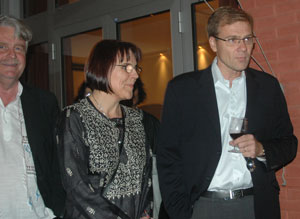 A hectic day starting with a visit to the Institute of Social Sciences (ISS), located at 8, Nelson Mandela Marg in New Delhi.
From ISS we went to the Centre for the Study of Developing Societies (CSDS) at 29 Rajpur Road.
A hectic day starting with a visit to the Institute of Social Sciences (ISS), located at 8, Nelson Mandela Marg in New Delhi.
From ISS we went to the Centre for the Study of Developing Societies (CSDS) at 29 Rajpur Road.
In the evening a reception and dinner was organised in honour of SASNET at the Swedish Embassy in New Delhi by the Counsellor Anders Sjöberg (seen on the photo to the right along with Lars Eklund and Anna Lindberg).
Report from the Institute of Social Sciences (ISS)
Report from the Centre for the Study of Developing Societies (CSDS)
Report from the Swedish Embassy
Saturday 3 November 2007:
Full day meeting with SASNET’s South Asian Reference Group (see http://www.sasnet.lu.se/asiareggroup.html) at the NCI flat in Nizamuddin East.
Report from the SASNET’s South Asian Reference Group meeting
Sunday 4 November 2007:
 A resting day after some very hectic days. Our only mission for the day was to have lunch with Dr. Manoj Sinha and his family, living in Noida (Sector 21) on the other side of Yamuna, giving us an opportunity to try the new toll bridge over to Noida. Dr. Sinha is currently working at the Indian Society of International Law, but has a Swedish connection in the fact that he was a Guest Professor at the Raoul Wallenberg Institute for Humanitarian Law, Lund University in 2005.
A resting day after some very hectic days. Our only mission for the day was to have lunch with Dr. Manoj Sinha and his family, living in Noida (Sector 21) on the other side of Yamuna, giving us an opportunity to try the new toll bridge over to Noida. Dr. Sinha is currently working at the Indian Society of International Law, but has a Swedish connection in the fact that he was a Guest Professor at the Raoul Wallenberg Institute for Humanitarian Law, Lund University in 2005.
Monday 5 November 2007
Another hectic day in Delhi, visiting both TERI (The Energy and Resources Institute) at India Habitat Centre, and the Developing Countries Research Centre (DCRC) at Delhi University. In the evening we also visited the Vice-Chancellor of Delhi University, and had a dinner meeting with researchers from the natural sciences at Delhi University north campus, hosted by Prof. K. Sreenivas, Dean International Relations, Delhi University.
Report from The Energy and Resources Institute (TERI)
Report from the Developing Countries Research Centre (DCRC), Delhi University
Meeting with Vice-Chancellor of Delhi University
Meeting with researchers in Science, Delhi University
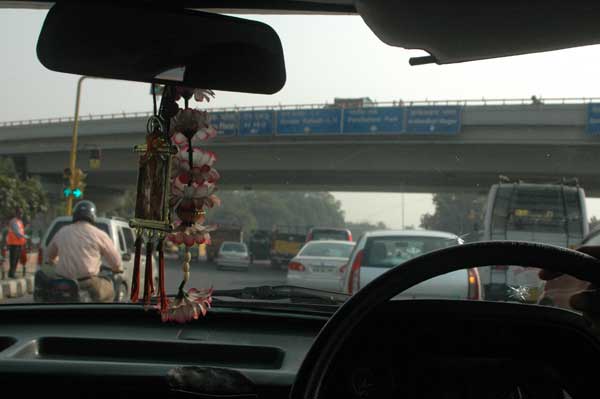 Tuesday 6 November 2007
Tuesday 6 November 2007
In the morning we visited the University Grants Commission (UGC) and met its Director, Prof. Sukhadeo Thorat. In the afternoon we went to another of the major Delhi universities, the Jamia Millia Islamia University, where a meeting was held with Prof. Lakshmi Subramaniam from the Department of History. We were also introduced to the Vice-Chancellor, Prof. Mushirul Hasan.
Report from the University Grants Commission (UGC)
Report from Jamia Millia Islamia University
In the evening we had a meeting over dinner with Prof. Bishnu Mohapatra from the Centre for Political Studies at Jawaharlal Nehru University, at the India International Centre near to Lodi Gardens.
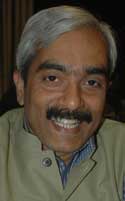 Prof. Mohapatra (photo to the right) is well-known to SASNET and Swedish researchers, through collaborative research projects with Dr. Hans Blomkvist, Dept. of Government, Uppsala University, and Dr. Catarina Kinnvall, Dept. of Political Science, Lund University. (Staffan Lindberg and Lars Eklund also met Prof. Mohapatra during their SASNET South Asian contact journey in March 2002. Read the report from the meeting).
Prof. Mohapatra (photo to the right) is well-known to SASNET and Swedish researchers, through collaborative research projects with Dr. Hans Blomkvist, Dept. of Government, Uppsala University, and Dr. Catarina Kinnvall, Dept. of Political Science, Lund University. (Staffan Lindberg and Lars Eklund also met Prof. Mohapatra during their SASNET South Asian contact journey in March 2002. Read the report from the meeting).
Since several years, Prof. Mohapatra is also connected to the Ford Foundation, working as Program Officer at its South Asia office in New Delhi, being responsible for Ford Foundation’s funding activities in India, Nepal and Sri Lanka.
Thiruvanthapuram
 Wednesday 7 November 2007
Wednesday 7 November 2007
After a week in Delhi it was now time to fly south, all the way down to Thiruvanthapuram, capital of the south-western state of Kerala. Our Jet Airways flight departed Delhi at 8 o’clock in the morning, and via a technical stop-over in Mumbai we landed at Trivandrum International Airport five hours later.
We went straight away to the Centre for Development Studies (CDS), located outside the city, where we were given accommodation in its simple but very charming guest house. Dr. J. Devika, our SASNET reference group member, had arranged for a meeting with the CDS Director Prof. K.N. Nair in the afternoon. In the evening Prof. Nair also took us out for a buffet dinner at Mascot Hotel in the central part of Thiruvananthapuram.
Report from the Centre for Development Studies (CDS)
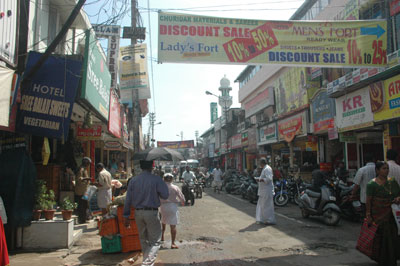 Thursday 8 November 2007
Thursday 8 November 2007
Diwali Day, a holiday all over India. Still we managed to visit the Trivandrum Medical College (TMC), deeply involved in collaboration with Karolinska Institutet Medical University in Sweden. We were hosted by Prof. K.T. Shenoy, new Dean for the Faculty of Medicine, Kerala University, shown around the campus, and and had a fruitful meeting in the Principal’s office.
Prof. Shenoy then brought us to the independent Population Health and Research Institute, run by Prof. Shenoy and colleagues. The institute is doing good work on research concerning tobacco and its health hazards.
The rest of the day we wandered around the city of Thiruvananthapuram, a city currently changing fast. Old traditional houses in the city centre are demolished, giving way for a widening of roads and construction of modern buildings.
Report from Trivandrum Medical College (TMC)
Friday 9 November 2007
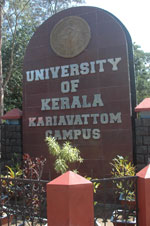 In the morning we visited Loyola College of Social Science, affiliated to the University of Kerala, and in the afternoon we visited the Department of Communication and Journalism at the University of Kerala Kariavattom Campus. Both the institutions have Swedish connections, Loyola College with Österlen Folk High School in Tomelilla, and the Dept. of Communication and Journalism with Karlstad University.
In the morning we visited Loyola College of Social Science, affiliated to the University of Kerala, and in the afternoon we visited the Department of Communication and Journalism at the University of Kerala Kariavattom Campus. Both the institutions have Swedish connections, Loyola College with Österlen Folk High School in Tomelilla, and the Dept. of Communication and Journalism with Karlstad University.
In the evening we travelled by taxi to Odayam, a fishing village north of the tourist resort Varkala. Here we spent the weekend relaxing.
Report from Loyola College of Social Sciences
Report from the Dept. of Communication and Journalism, University of Kerala
Saturday 10 November 2007
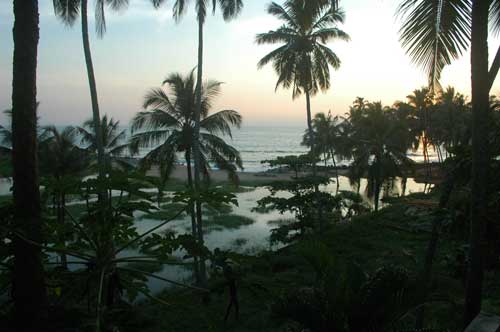 Resting day in Odayam
Resting day in Odayam
Sunday 11 November 2007
Resting day in Odayam
Kottayam
Monday 12 November 2007
Departure from Odayam at 06.30, travel by road four hours north along the coast to Kottayam. Accommodation at Hotel Homestead, near the Kottayam Railway Station, and opposite to the office of Malayala Manorama, the leading newspaper of Kerala.
At 11.00 a meeting was organised for us at the School of Social Sciences, Mahatma Gandhi University. The Director, Dr. Rajan Gurukkal, unfortunately had had to go to Delhi, but we were hosted by hos colleagues instead.
In the afternoon we made visits to the most renowned of the Syrian Orthodox churches that Kottayam is full of.
Report from School of Social Sciences, Mahatma Gandhi University
Kozhikode
Tuesday 13 November 2007
 Comfortable train journey in chair car from Kottayam.
After six hours we arrived in the beautiful city of Kozhikode (formerly known as Calicut) at 4 o’clock in the afternoon, and proceeded straight away to the Indian Institute of Management (IIM) in Kunnamangalam, 15 km outside the city centre. From Kottayam with its large Christian population and many churches we now came to the Malabar region, to some extent dominated by Muslims. Along the excellent roads we passed several mosques and Islamic schools.
Comfortable train journey in chair car from Kottayam.
After six hours we arrived in the beautiful city of Kozhikode (formerly known as Calicut) at 4 o’clock in the afternoon, and proceeded straight away to the Indian Institute of Management (IIM) in Kunnamangalam, 15 km outside the city centre. From Kottayam with its large Christian population and many churches we now came to the Malabar region, to some extent dominated by Muslims. Along the excellent roads we passed several mosques and Islamic schools.
IIMK is located on a picturesque hillside, with a wonderful view over the palm-covered landscape of central Kerala from every nook and corner of IIMK. The airy buildings of the institute, as well as the hostels, guesthouses and the residential buildings for the professors, all beautifully designed by the architectural firm Mani Chowfla in New Delhi only five years ago, add to the charm of the place.
Since we were provided with rooms in one of the guesthouses, we were able to have meetings with faculty members both in the evening and the next morning, before our onward journey to Mumbai.
Report from the Indian Institute of Management Kozhikode (IIMK)
Mumbai
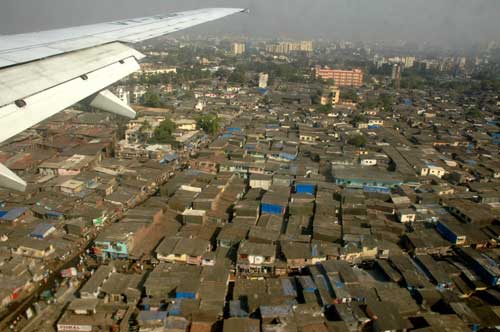 Wednesday 14 November 2007
Wednesday 14 November 2007
In the afternoon we flew with a Jet Airways flight from Kozhikode, and arrived in Mumbai at 4 o’clock (view from the air just before the landing on the photo to the right). We proceeded straight away to the University of Mumbai and its Kalina Campus located in Vidyanagari, Santa Cruz East. There we were accommodated in one of the university guest houses. Our host was Dr. Rajesh Kharat, a political scientist from the Department of Civics & Politics. Dr. Kharat has been connected to SASNET since 2002, when he came to Lund University and held a SASNET guest lecture on ”The Bhutan Refugee Problem”. He is a qualified expert on Bhutan, Tibet, the refugee situation in the region, and more generally about the political and economic cooperation in South Asia, in 1999 he published the book ”Bhutan in SAARC: Role of a Small State in a Regional Alliance”.
Thursday 15 November 2007
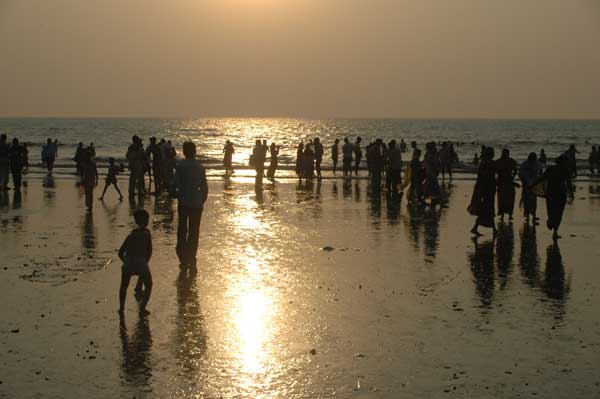 The day was devoted to a visit to the prominent Indian Institute of Technology (IIT) Bombay, at Powai in the northeastern part of Mumbai. Our programme had been organised by Prof. Pradipta P. Banerjee, Dean for International Relations, and included separate meetings at the departments of Civil Engineering, Computer Science and Engineering, Humanities and Social Sciences, and Electrical Engineering.
The day was devoted to a visit to the prominent Indian Institute of Technology (IIT) Bombay, at Powai in the northeastern part of Mumbai. Our programme had been organised by Prof. Pradipta P. Banerjee, Dean for International Relations, and included separate meetings at the departments of Civil Engineering, Computer Science and Engineering, Humanities and Social Sciences, and Electrical Engineering.
On the way back to Santa Cruz we spent some time on the Juhu Beach, a fascinating place crowded with people enjoying the sunset along the Indian Ocean (photo to the right).
Report from the Indian Institute of Technology Bombay (IITB)
Friday 16 November 2007
 Resting day in Mumbai. Time to see some of the interesting places in the city, along with Ms. Sana Siddiqui, one of Dr. Kharat’s students in Political scence. Haji Ali mosque (photo), Jehangir Art Gallery, Leopold’s Restaurant, etc.
Resting day in Mumbai. Time to see some of the interesting places in the city, along with Ms. Sana Siddiqui, one of Dr. Kharat’s students in Political scence. Haji Ali mosque (photo), Jehangir Art Gallery, Leopold’s Restaurant, etc.
In the evening a Jet Airways flight to Aurangabad, reaching there at 9 P.M. A car was waiting for us to bring us to Pravara Rural Health University in Loni, a three hours drive westwards on bumpy Mahashtrian roads.
Accommodated in the excellent university guest house.
Loni, Maharashtra
Saturday 17 November 2007
Visiting the Pravara Institute of Medical Sciences – Deemed University, meeting its dynamic Vice Chancellor Dr. Ashok Patil (also connected to Skövde University). Study visits to the different departments and travelling to field projects. In the evening a reception in the VC’s garden with a visiting delegation from Linköping University.
Report from Pravara Institute of Medical Sciences – Deemed University, Loni
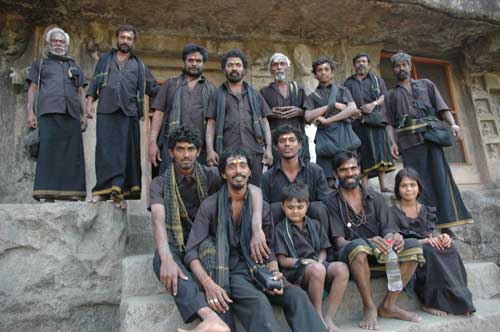 Sunday 18 November 2007
Sunday 18 November 2007
Resting day. Visit to Ellora caves (where we met the pilgrims on the photo to the right). Departure by car from Loni early in the morning.
Overnight stay at hotel in Aurangabad.
Mumbai (again)
Monday 19 November 2007
Jet Airways flight from Aurangabad back to Mumbai, and the WRIC (Western Regional Instrumentation Centre) guest house at the University of Mumbai Kalina Campus in Vidyanagari, Santa Cruz East.
Visits to the University of Mumbai in the afternoon.
Report from University of Mumbai/
Dept. of Civics and Politics
& Dept. of History
Tuesday 20 November 2007
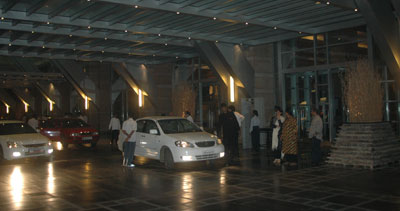 Visit to the Tata Institute of Social Sciences (TISS).
Visit to the Tata Institute of Social Sciences (TISS).
Report from the Tata Institute of Social Sciences (TISS)
Since this was our final night in Mumbai, we managed to meet our host Dr. Kharat, after his return from an official journey to Delhi. We invited him, along with his wife Barthi, to a most delicious dinner in the authentic China House restaurant – one of India’s most splendid restaurants and Mumbai’s celebrity den No. 1, according to India Today magazine 16 Nov. 2007 – within the Hotel Grand Hyatt in Vidyanagari (photo). It was only a short distance away from the University of Mumbai Kalina Campus. We had good discussions with Dr. Kharat on how to interact more in the future.
Wednesday 21 November 2007
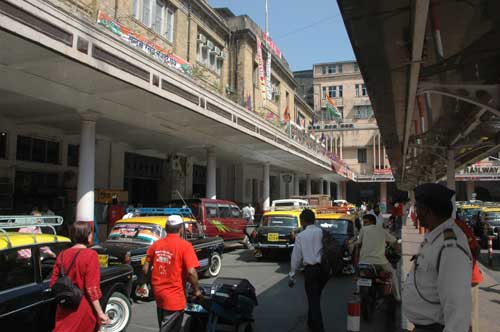 We had an ambition to meet the Vice Chancellor of the University of Mumbai, but unfortunately it was not possible. Instead we had a meeting with Dr. V.N. Magare, Director of the Board of College and University Development, to discuss possible Indo-Swedish collaboration on students exchange. After that, Anna gave a lecture for the students at the Dept. of Civics and Politics, before we checked out from the rooms at the guest house and proceeded to Chhatrapati Shivaji Terminus (formerly Victoria Terminus) in central Mumbai.
We had an ambition to meet the Vice Chancellor of the University of Mumbai, but unfortunately it was not possible. Instead we had a meeting with Dr. V.N. Magare, Director of the Board of College and University Development, to discuss possible Indo-Swedish collaboration on students exchange. After that, Anna gave a lecture for the students at the Dept. of Civics and Politics, before we checked out from the rooms at the guest house and proceeded to Chhatrapati Shivaji Terminus (formerly Victoria Terminus) in central Mumbai.
Report from University of Mumbai/
Board of College and University Development
Pune
After a pleasant three hours train journey in chair car with the Sinhagad Express we reached Pune with its significantly cooler climate in the early evening.
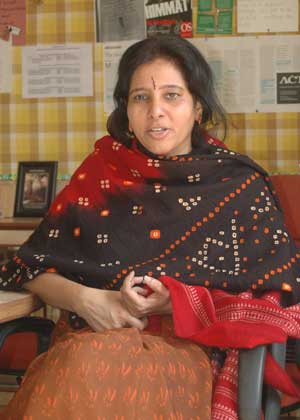 We were picked up at the railway station and taken to the Orchid Learning and Development Centre (Orchid School), a private trust institution involved in Örebro University’s India Project since 1994. The driving force behind Orchid School, Ms. Lakshmi Kumar (photo to the right), welcomed us to Pune, and quite unexpectedly for us a big reception had been organised in the evening with invited ”Swindian” guests, speeches and delicious maharashtrian food in honour of our visit to Pune. The guests included several people involved in different exchange programmes with Swedish universities, and also the students in Social Work from the universities of Örebro, Östersund, Stockholm, Lund and Göteborg that spent the autumn 2007 in Pune, doing fieldwork within the framework of the India Project. A few of them, we had actually met a week earlier in Varkala, Kerala.
We were picked up at the railway station and taken to the Orchid Learning and Development Centre (Orchid School), a private trust institution involved in Örebro University’s India Project since 1994. The driving force behind Orchid School, Ms. Lakshmi Kumar (photo to the right), welcomed us to Pune, and quite unexpectedly for us a big reception had been organised in the evening with invited ”Swindian” guests, speeches and delicious maharashtrian food in honour of our visit to Pune. The guests included several people involved in different exchange programmes with Swedish universities, and also the students in Social Work from the universities of Örebro, Östersund, Stockholm, Lund and Göteborg that spent the autumn 2007 in Pune, doing fieldwork within the framework of the India Project. A few of them, we had actually met a week earlier in Varkala, Kerala.
Ms. Kanishka from the Orchid School had been kind enough to finalise our programme for the three days we were going to stay in Pune, including a visit back to Orchid School on the final day in town. We were accommodated in the Sahara Hotel, close to the beautiful Chaturshringi Temple on Senapati Bapat Road.
Report from the Orchid Learning and Development Centre (Orchid School)
Thursday 22 November 2007
Visiting Pune University, both the Dept. of Environmental Sciences, involved in collaboration with Jönköping University, the Women’s Studies Centre, and the International Students Centre. In the evening we managed to meet the Vice Chancellor, Dr. Narendra Jadhav. Inbetween, in the afternoon, we visited the Gokhale Institute of Politics and Economics.
Report from University of Pune
Report from Gokhale Institute of Politics and Economics
Friday 23 November 2007
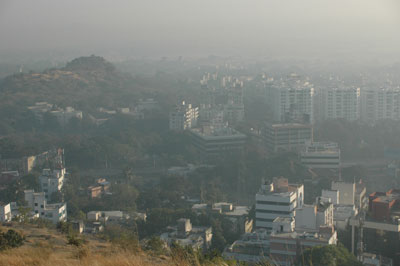 In the morning we visited the National Chemical Laboratory (NCL), an institution in close collaboration with the Dept. of Biotechnology in Lund. After lunch at Orchid School, we proceeded in the afternoon to the Institute of Tropical Meteorology, also involved in Swedish collaboration, with the Dept. of Meteorology in Stockholm and the Water Resources Engineering division in Lund.
In the morning we visited the National Chemical Laboratory (NCL), an institution in close collaboration with the Dept. of Biotechnology in Lund. After lunch at Orchid School, we proceeded in the afternoon to the Institute of Tropical Meteorology, also involved in Swedish collaboration, with the Dept. of Meteorology in Stockholm and the Water Resources Engineering division in Lund.
Report from National Chemical Laboratory (NCL)
Report from Institute of Tropical Meteorology
In the evening we met the American scholar Dr. Gail Omvedt who has been residing in Maharashtra for many years. She is now working as coordinator at the School of Social Justice (SSJ), Pune University. We spent the evening together, having dinner at the charming Sarovar outdoor restaurant.
Saturday 24 November 2007
Leaving Pune at noon, with a Kingfisher Airlines flight to Bangalore.
Bangalore
 We arrived in Bangalore at around 3 P.M. and hired a taxi to take us through the maddening traffic of Bangalore to Nagarbhavi in the extreme south of the city, and the Institute of Social and Economic Change (ISEC) guest house. Prof. R.S. Deshpande, Head for the Agricultural Development and Rural Transformation Centre at ISEC, had kindly arranged for us to stay in the guest house during our Bangalore visit. Dr. Deshpande is well-known to us since he has had several research cooperation projects with Sweden and Denmark, and he convened a panel (together with Dr. Neelambar Hatti, Lund University) on ”Institutions and Agricultural Development” at the 18th European Conference on Modern South Asian Studies, that SASNET organised in Lund in 2004 (more information about the panel).
We arrived in Bangalore at around 3 P.M. and hired a taxi to take us through the maddening traffic of Bangalore to Nagarbhavi in the extreme south of the city, and the Institute of Social and Economic Change (ISEC) guest house. Prof. R.S. Deshpande, Head for the Agricultural Development and Rural Transformation Centre at ISEC, had kindly arranged for us to stay in the guest house during our Bangalore visit. Dr. Deshpande is well-known to us since he has had several research cooperation projects with Sweden and Denmark, and he convened a panel (together with Dr. Neelambar Hatti, Lund University) on ”Institutions and Agricultural Development” at the 18th European Conference on Modern South Asian Studies, that SASNET organised in Lund in 2004 (more information about the panel).
Unfortunately for us, Dr. Deshpande was not at ISEC when we arrived, since he had had to go on an official tour to Delhi, and neither had a joint meeting been possible to organise with the researchers at the institute. However, we managed to arrange for a meting with the ISEC Director, Dr. N. Jayaram late on Saturday afternoon.
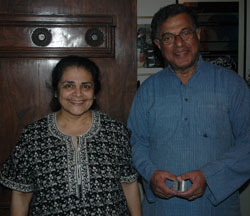
Report from Institute of Social and Economic Change (ISEC)
Sunday 25 November 2007
Resting day. Lunch with Saras Ganapathy and Girish Karnad (photo to the right), friends of Lars, in their JP Nagar house just south of the Bangalore city centre. We were offered to move over here from Nagarbhavi, and so we did the following day.
Monday 26 November 2007
Visit to Indian Institute of Science (IISc), the top-ranked Indian university all categories, and an institution involved in several Indo-Swedish collaboration programmes.
Report from Indian Institute of Science (IISc)
Tuesday 27 November 2007
Visit to Indian Institute of Management (IIM Bangalore), with a meeting at the Centre for Public Policy (CPP), involved in collaboration with several Swedish universities. By chance we also met Mr. Stefan Jonsson, Counsellor for Science and Technology at the Swedish Embassy in New Delhi, at IIMB. We last met him three weeks earlier in Delhi. He had come to Bangalore with a delegation of people from the Region Västra Götaland (Västra Götalandsregionen), here to develop collaboration in different fields, including education, trade, culture, etc, with the regional Karnataka state government. A new form of development assistance that the Swedish government promotes. We had a nice conversation with Mr. Jonsson, discussing our impressions and experiences from our one-month tour in India, visiting 30 different universities and research institutions.
Report from Indian Institute of Management (IIM), Bangalore
 In the afternoon we visited Christ College, affiliated to Bangalore University. In 2005, the National Assessment and Accreditation Council (NAAC) – an independent Council under the Indian University Grants Commission (UGC) – declared Christ College to be a ”College with Potential for Excellence”, the first of its kind in Karnataka. Christ College has collaboration agreements with universities in many countries, including Trondheim, and has set up a number of specialised research centres. More information about Christ College, Bangalore.
In the afternoon we visited Christ College, affiliated to Bangalore University. In 2005, the National Assessment and Accreditation Council (NAAC) – an independent Council under the Indian University Grants Commission (UGC) – declared Christ College to be a ”College with Potential for Excellence”, the first of its kind in Karnataka. Christ College has collaboration agreements with universities in many countries, including Trondheim, and has set up a number of specialised research centres. More information about Christ College, Bangalore.
 However, the only thing we knew about Christ College before coming to Bangalore was that a upper secondary school in southern Sweden, Österportgymnasiet in Ystad, had sent students for fieldwork there in 2006. One of the students with whom we had been in contact, Viktoria Hansson (photo to the left), then returned in the Fall 2007 to participate in a training programme that Christ College, through its
Centre for Social Action (CSA), organises in collaboration with the Norwegian government funded organisation Fredskorpset (Peace Corps). We had made an appointment with Viktoria to meet her at Christ College to show us around the premises and the campus, which she did. By chance, it then also turned out that this was the second and last day of an International conference that the Centre for Social Action held at Christ College, a conference focusing on ”Women in Emerging Indian Economy – Silence to Voice: Problems and Possibilities”. The conference was organised in collaboration with Fredscorpset and Drik India in Kolkata, and when the participants came out from the session hall, to our surprise it turned out that several researchers and activists well-known to us were participating. More information about the conference.
However, the only thing we knew about Christ College before coming to Bangalore was that a upper secondary school in southern Sweden, Österportgymnasiet in Ystad, had sent students for fieldwork there in 2006. One of the students with whom we had been in contact, Viktoria Hansson (photo to the left), then returned in the Fall 2007 to participate in a training programme that Christ College, through its
Centre for Social Action (CSA), organises in collaboration with the Norwegian government funded organisation Fredskorpset (Peace Corps). We had made an appointment with Viktoria to meet her at Christ College to show us around the premises and the campus, which she did. By chance, it then also turned out that this was the second and last day of an International conference that the Centre for Social Action held at Christ College, a conference focusing on ”Women in Emerging Indian Economy – Silence to Voice: Problems and Possibilities”. The conference was organised in collaboration with Fredscorpset and Drik India in Kolkata, and when the participants came out from the session hall, to our surprise it turned out that several researchers and activists well-known to us were participating. More information about the conference.
Mysore
Wednesday 28 November 2007
We left Bangalore with the Shatabdi Express train at 11 A.M. and reached Mysore in exactly two hours time. In accordance with the Indian tradition, we were heartily welcomed at the railway station with flower garlands by Dr. Suresh Patil from the Anthropological Survey of India (ASI), and Dr. Kikkeri Narayana from the Central Institute of Indian Languages (CIIL), who had been kind enough to plan for our programme in Mysore.
 After some hectic weeks mostly spent in big cities in India with their high levels of air pollution, it was pleasant to arrive at the beautiful, small city of Mysore where the air felt fresh and clean. The city has many historical buildings connected to the Maharaja of Mysore (the main palace on the photo to the right), and in many parts the city looks like a museum of architecture. It is known as the cultural capital of Karnataka, and it is also famous for having a pleasant climate all year round.
After some hectic weeks mostly spent in big cities in India with their high levels of air pollution, it was pleasant to arrive at the beautiful, small city of Mysore where the air felt fresh and clean. The city has many historical buildings connected to the Maharaja of Mysore (the main palace on the photo to the right), and in many parts the city looks like a museum of architecture. It is known as the cultural capital of Karnataka, and it is also famous for having a pleasant climate all year round.
We went straight to to the wonderful new-built guest house (truly the best guest house we have ever experienced anywhere) belonging to the CIIL, where we were going to stay for two nights. Afther lunch, we proceeded for meetings at the Anthropological Survey of India.
Report from Anthropological Survey of India
 Thursday 29 November 2007
Thursday 29 November 2007
Visiting the Central Institute of Indian Languages (CIIL) in the morning, meeting its dynamic Director, Prof. Udaya Narayana Singh and his colleagues. In the afternoon visiting University of Mysore, meeting the Vice Chancellor and the Chairs of several faculties. Also round tour of the university and a visit to some of the departments, kindly organised by Lawrence Surendra, holder of the Planning Commission Professorial Chair at the Department of Economics.
Report from Central Institute of Indian Languages (CIIL)
Report from University of Mysore
In the evening, Lawrence Surendra, who has spent long time in Sweden and has several Swedish collaboration partners, kindly invited us to visit his farmhouse outside Mysore, and having dinner with his wife Pushpa.
Bangalore (again)
Friday 30 November 2007
We had a short sightseeing tour of the charming city of Mysore – recently said to be one of the ten most attractive Indian cities to live in (according to the India Today magazine), and saw its magnificent maharaja palace and the beautiful St. Philomena's Cathedral (photo to the right). It is true, Mysore is still a rather peaceful place and the traffic is nothing compared to Bangalore. Still we had to leave Mysore, and go back to Bangalore, this time by taxi. We came just in time for our last scheduled meeting, for a visit to the Centre for the Study of Culture & Society (CSCS).

Report from Centre for the Study of Culture & Society (CSCS)
In the evening, Anna flew back to Thiruvananthapuram with a Kingfisher Airlines flight, to spend the coming four weeks again working on her ongoing research project on changing marital traditions in South India. Anna returned back to Sweden on Sunday, December 23.
Lars spent his last evening in Bangalore meeting his old friend and colleague from the SYDASIEN magazine, the Swedish writer Zac O’Yeah, since some years permanently residing in Bangalore with his wife, the poet Anjum Hasan. Lars and Zac (photo to the right) had dinner at the legendary Koshy’s Restaurant in central Bangalore, before Lars had to proceed to the airport in the middle of the night and fly back home to Sweden with a Lufthansa flight. Back to work at the SASNET root node office in Lund.
Lund 25 January 2008, Lars Eklund & Anna Lindberg,
SASNET
SASNET - Swedish South Asian Studies Network/Lund
University
Address: Scheelevägen 15 D, SE-223 70 Lund, Sweden
Phone: +46 46 222 73 40
Webmaster: Lars Eklund
Last updated
2009-04-09
SASNET - Swedish South Asian Studies Network/Lund
University
Address: Scheelevägen 15 D, SE-223 70 Lund, Sweden
Phone: +46 46 222 73 40
Webmaster: Lars Eklund
Last updated
2009-04-09
